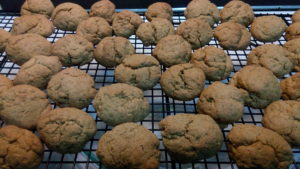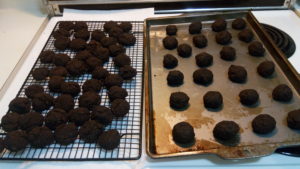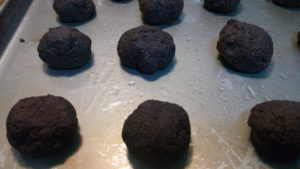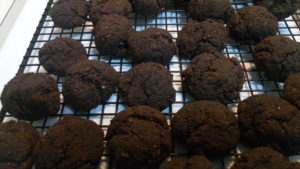Electromagnetic fields, (EMFs) are the non-ionizing radiation that makes WiFi connections work and other devices like televisions and cellphones. The electronic details are beyond my field of experience and they are generally claimed to be harmless however research is being done on the health effects on people and other species. As more and more ‘hotspots’ become active and there is discussion of making entire regions WiFi spots the question of whether the radiation is truly harmless or not is important.
The research that has been performed suggests that the mode of action is on the ion channels in cell membranes called voltage-gated calcium channels (VGCCs). The EMF radiation seems to activate ion channels and allows the interior of the cell to fill with calcium which then can proceed to activate membrane breakdown and other actions within the cell. Oxidative stress can involve an excess of calcium within the interior of the cell which leads to other free radical chemicals – electrically active chemicals which antioxidant nutrients can help deactivate. See: (1)
Oxidation is a normal part of cell function as it is how glucose sugar energy is freed for use. Too many oxidative free radical chemicals also called, reactive oxygen species (ROS), can overpower the natural antioxidant chemical pathways and lead to increased cell damage and even cell death. (2, 3, 4)
Ion channels refer to chemicals that contain atoms that have a positive or negative charge which can be used to provide energy for chemical reactions. Ions in nature generally are found in pairs with a balance of positive and negative charges so the grouping is fairly stable. Calcium and magnesium both have ionic forms with a chemical charge of +2, which means they are missing two electrons. Sodium and potassium have ionic forms with a chemical charge of +1 – they are missing one electron each.
An ion is an atom or chemical that has more protons than electrons and carries a positive charge or has more electrons than protons and carries a negative charge, while a free radical specifically has at least one unpaired electron in its outer electron shell/valence which makes it very reactive but does not necessarily mean an electron is missing nor suggest a negative charge. Depending on their chemistry they may be able to receive or donate another electron and are very reactive, very active chemically, as the outer shell prefers to be stable chemically. The presence of an unpaired electron makes the free radical chemically encouraging other chemicals to give up or receive the unpaired electron even if the other chemical is more chemically stable. (7) The electrons in an atom are arranged around the inner ball of positively charged protons and neutrally charged neutrons in layers of electrons (valences) which prefer to be in groups of 2, 6 or 8 electrons, so a free radical with an outer layer with one electron might want to donate it while one with an outer shell with seven electrons might want to receive an extra electron. Element valences are slightly different than what might be expected looking at the Table of Elements – here is a chart of the typical ion or free radical charges: (6)
Oxygen can carry an electrically negative charge of -2, meaning it can accept two additional electrons in its outer valence. (6) And hydrogen can accept or donate an electron, +1 or -1, (6) which chemically can result in our most important molecule for life – water, H2O, formed from two atoms of hydrogen sharing their unpaired outer electron with one atom of oxygen which wants an additional two electrons. The slight preference for different electric charges gives the molecule of water a slight polarity, the oxygen part of the water molecule has a slight negative charge on average while the hydrogen parts of the molecule have slight positive charges. (8) A more thorough description of the chemical structure of the water molecule and its electrical charge distribution with illustrations is available here: (12).
Why is this important? Because our bodies are made up of at least 70% water and electromagnetic radiation does have effects on water (9) so a basic understanding of the chemistry can help understand the more complex issues of why having region wide areas of WiFi might affect health of humans and other animals, plants and possibly even microbial life. There is evidence that microbes can modify nearby DNA via EMFs generated by the microbial DNA when both sets of DNA are in a watery dilution. (10, [1602 from ref 9]) This may increase risk of infection or cross contamination of infectious substances. We don’t know what we don’t know. The research may simply confirm the need to be concerned about Electromagnectic fields on DNA. The negative effect of EMF exposure to DNA and an increase in DNA breakdown/fragmentation was mentioned in the first link. See: (1).
Research that looked for epigenetic effects on DNA that might be associated with leukemia or other cancerous changes found that Extremely Low Frequency-Magnetic Fields which have been labeled potentially carcinogenic as some association with leukemia has been noted, did not consistently lead to epigenetic changes in the study. Changes that did occur were more likely to be found when the genetic material, called chromatin, was in a more open and active form rather than when it was in the condensed, non-replicating form. (13) Pregnancy would be a time when DNA is expected to be more active, and infancy and childhood are also times when growth and replication of cells is expected. Concerns and a review of available research about the risk of EMF radiation for adults and childhood development is discussed in a Special Section of the journal Childhood Development: (14)
Calcium channel blocker medications have been found to help reduce the effects of EMF radiation for individuals who seem to be more sensitive to ill effects from the form of radiation than the average person. See: (1)
Magnesium is nature’s calcium channel blocker so there may be an underlying deficiency of magnesium in the the people who are more sensitive to EMFs. A number of conditions can make the intestines absorb less magnesium and more calcium than average and the kidneys can be better at holding onto calcium and more likely to excrete magnesium than average. The food and water supply is not as rich in magnesium as it was during earlier centuries of human development. Magnesium deficiency as a risk factor in sensitivity to EMFs is discussed in the first link and it introduces a protective factor that can be increased with more variety of vegetables and other phytochemical rich foods in the diet – nuclear factor erythroid-2-related factor 2 (Nrf2). See: (1)
Specific foods or phytochemicals mentioned to help increase Nrf2 include:
- sulforaphane from cruciferous vegetables, (such as broccoli and cauliflower);
- foods high in phenolic antioxidants, (This is a large group including bright yellow and red fruits and vegetables, and deep purple produce. The group includes the subgroup flavonoids which include anthocyanins, flavonols, and it also includes the less familiar subgroup chalcones which are found in the commonly used fruits apples, pears and strawberries. The group also includes aldehydes which are found in vanilla and cinnamon, phenolic acids which include salicyclic acid, and tannins which are found in tea, coffee and wine. Baking cocoa and cherries, beans and whole grains are also mentioned, the summary point would be eat more fruits and vegetables; see: (11))
- the long-chained omega-3 fats DHA and EPA, (salmon, tuna, sardines, krill oil, ground flax meal, walnuts, hemp seed kernels);
- carotenoids (especially lycopene), (such as carrots, winter squash, sweet potatoes, cantaloupe, apricots, and lycopene is in tomato, watermelon, pink grapefruit, guava);
- sulfur compounds from allum vegetables, (such as onions, garlic, shallots, green onions);
- isothiocyanates from the cabbage group and
- terpenoid-rich foods. (Terpenes are found in real lemon and lime oil, rosemary, oregano, basil and other aromatic green herbs).
- The Mediterranean and the traditional Okinawan Diets are also mentioned as being Nrf2 promoting diets. See: (1)
A 2012 article that discusses the science known at the time and reviews cellphone cases designed to redirect EMF radiation away from the user available at the times suggests some health evidence exists but that the information is not conclusive yet but that no study has been longer than ten years. Children have less dense bone structure and may be accumulating more life time exposure so limiting use of cellphones around children or their use by children may be playing it safer until more research is available. (5) Turning off cellphones when not needed can save battery time and would be turning off the WiFi when it is not needed. You can always check for messages when you turn it back on again. Using a hard wired computer at home or at least turning off the laptop at night is recommended along with other tips in the first link. See: (1)
Disclaimer
Disclaimer: Opinions are my own and the information is provided for educational purposes within the guidelines of fair use. While I am a Registered Dietitian this information is not intended to provide individual health guidance. Please see a health professional for individual health care purposes.
The Academy of Nutrition and Dietetics has a service for locating a nutrition counselor near you at the website eatright.org: (eatright.org/find-an-expert)
- Joseph Mercola, The Harmful Effects of Electromagnetic Fields Explained, wakeup-world.com, Dec. 22, 2017, https://wakeup-world.com/2017/12/22/the-harmful-effects-of-electromagnetic-fields-explained/ (1)
- Chapter 1: Cell Injury, Cell Death,
and Adaptations, sample, not final copy, Elsevier, pdf http://www.newagemedical.org/celldeath-injury-link2.pdf (2)
- Khalid Rahman, Studies on free radicals, antixidants, and co-factors., Clin Interv Aging. 2007 Jun; 2(2): 219–236., https://www.ncbi.nlm.nih.gov/pmc/articles/PMC2684512/ (3)
-
V. Lobo, A. Patil, A. Phatak, and N. Chandra, Free radicals, antioxidants and functional foods: Impact on human health, Pharmacogn Rev. 2010 Jul-Dec; 4(8): 118–126., https://www.ncbi.nlm.nih.gov/pmc/articles/PMC3249911/ (4)
-
Joseph Hanlon, Radiation-reducing phone cases: saviours or snake oil?, Aug. 13, 2012, https://www.cnet.com/news/radiation-reducing-phone-cases-saviours-or-snake-oil/ (5)
- Helmenstine, Anne Marie, Ph.D. “Valences of the Elements – Chemistry Table.” ThoughtCo, Mar. 7, 2017, thoughtco.com https://www.thoughtco.com/valences-of-the-elements-chemistry-table-606458 (6)
- UCSB Science Line, What is the difference between ion and radical?, 04/01/2015, http://scienceline.ucsb.edu/getkey.php?key=4833 (7)
- Biochemistry, Chemistry Tutorial, The Chemistry of Water, biology.arizona.edu, http://www.biology.arizona.edu/biochemistry/tutorials/chemistry/page3.html (8)
- Martin Chaplin, Water Structure and Science: Magnetic and electric effects on water, 2001, last update by Martin Chaplin on Nov. 3, 2017, lsbu.ac.uk http://www1.lsbu.ac.uk/water/magnetic_electric_effects.html (9)
- [1602 from the above reference] L. Montagnier, J. Aïssa, S. Ferris, J.-L. Montagnier, C. Lavallée, Electromagnetic signals are produced by aqueous nanostructures derived from bacterial DNA sequences, Interdisciplinary Sciences: Computational Life Sciences, 1(2009) 81-90. L. Montagnier, J. Aissa, E. Del Giudice, C. Lavallee, A. Tedeschi and G. Vitiello, DNA waves and water, Journal of Physics.: Conference Series, 306 (2011) 012007, arXiv:1012.5166v1 (10)
- Maria de Lourdes Reis Giada, Chapter 4: Food Phenolic Compounds: Main Classes, Sources and Their Antioxidant Power, Biochemistry, Genetics and Molecular Biology » “Oxidative Stress and Chronic Degenerative Diseases – A Role for Antioxidants”, book edited by José A. Morales-González, ISBN 978-953-51-1123-8, Published: May 22, 2013 https://www.intechopen.com/books/oxidative-stress-and-chronic-degenerative-diseases-a-role-for-antioxidants/food-phenolic-compounds-main-classes-sources-and-their-antioxidant-power (11)
- Martin Chaplin, Water Structure and Science: Water Molecule Structure, 2000, last updated by Martin Chaplin Oct. 15, 2017, lsbu.ac.uk, http://www1.lsbu.ac.uk/water/water_molecule.html (12)
- Melissa Manser, Mohamad R. Abdul Sater, Christoph D. Schmid, Faiza Noreen, Manuel Murbach, Niels Kuster, David Schuermann, and Primo Schär,
ELF-MF exposure affects the robustness of epigenetic programming during granulopoiesis, Sci Rep. 2017; 7: 43345. https://www.ncbi.nlm.nih.gov/pmc/articles/PMC5339735/ (13)
- Cindy Sage, Ernesto Burgio, Electromagnetic Fields, Pulsed Radiofrequency Radiation, and
Epigenetics: How Wireless Technologies May Affect Childhood Development, Contemporary Mobile Technology and Child
and Adolescent Development, edited by Zheng Yan and Lennart Hardell, A Special Section of Child Development, 2017, Pages 1–8, https://eliant.eu/fileadmin/user_upload/de/pdf/Sage_Burgio_Childhood_2017_Epigenetics.pdf (14)
- https://www.hindawi.com/journals/bmri/2014/741018/
- Editors, Robert Vink, Mihai Nechifor, Magnesium in the Central Nervous System, free downloadable ebook, University of Adelaide Press, 2011, Adelaide.edu.au/press




